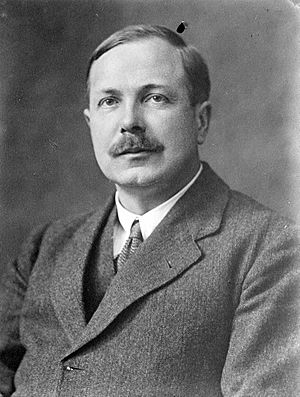Charles Galton Darwin facts for kids
Quick facts for kids
Charles Galton Darwin
|
|
|---|---|
 |
|
| Born |
Charles Galton Darwin
19 December 1887 Cambridge, England
|
| Died | 31 December 1962 (aged 75) Cambridge, England
|
| Nationality | British |
| Alma mater | Trinity College, Cambridge |
| Known for | Darwin term Darwin Lagrangian Darwin drift Darwin–Radau equation Darwin–Fowler method |
| Spouse(s) |
Katharine Pember
(m. 1925) |
| Children | 5, including Cecily and Henry |
| Parent(s) | George Howard Darwin Martha (Maud) du Puy |
| Relatives | Darwin–Wedgwood family |
| Awards | Royal Medal (1935) Fellow of the Royal Society |
| Scientific career | |
| Fields | Physicist |
| Institutions | National Physical Laboratory Victoria University of Manchester Royal Engineers Christ's College, Cambridge California Institute of Technology University of Edinburgh Manhattan Project |
| Academic advisors | Ernest Rutherford Niels Bohr |
Sir Charles Galton Darwin (born December 19, 1887 – died December 31, 1962) was an important English physicist. He was the director of the National Physical Laboratory (NPL) during World War II.
Charles Galton Darwin came from a famous family of scientists. He was the son of a mathematician, George Howard Darwin. Even more famously, he was the grandson of the well-known naturalist Charles Darwin, who developed the theory of evolution.
Contents
Early Life and Education
Charles Galton Darwin was born in Cambridge, England. His family was very involved in science. His father, Sir George Howard Darwin, was a mathematician. His mother was Maud du Puy from Philadelphia, Pennsylvania.
He had an older sister, Gwen Raverat, who was an artist. His younger sister, Margaret, married Geoffrey Keynes. Charles went to Marlborough College for his early education. Later, he studied mathematics at Trinity College, Cambridge. He earned his first degree in 1910.
A Career in Physics
After college, Darwin went to the Victoria University of Manchester. There, he worked with famous scientists like Ernest Rutherford and Niels Bohr. They were studying Rutherford's ideas about the atom.
In 1912, Darwin started using his math skills to help Henry Moseley. They worked on X-ray diffraction. This is how X-rays bend when they pass through materials. His research on X-rays helped explain how they interact with perfect crystals. He also introduced the idea of a "mosaic crystal" model.
World War I Contributions
When World War I started, Darwin joined the military. He was first sent to France as a censor. A year later, William Lawrence Bragg asked him to join the Royal Engineers. He helped develop ways to find enemy artillery using sound. This was called sound ranging. After that, he studied aircraft noise for the Royal Air Force.
Academic Work and Discoveries
From 1919 to 1922, Darwin taught at Christ's College, Cambridge. He worked with R.H. Fowler on statistical mechanics. Together, they created the Darwin–Fowler method. This method is used to solve problems in physics.
He then spent a year at the California Institute of Technology. In 1924, he became a professor at the University of Edinburgh. There, he studied quantum optics and magneto-optic effects. These fields look at how light and magnetism interact with tiny particles.
In 1928, he was the first to calculate the fine structure of the hydrogen atom. This was based on Paul Dirac's relativistic theory of the electron.
Leading the National Physical Laboratory
In 1938, Charles Galton Darwin became the director of the National Physical Laboratory (NPL). This was just before World War II began. He was a strong leader and worked to improve the laboratory.
During the war, he played a key role in the Manhattan Project. This was a secret project to develop the first atomic bomb. He helped coordinate the efforts of American, British, and Canadian scientists. For his important work, he was honored as a KBE in 1942.
Family Life
In 1925, Charles Galton Darwin married Katharine Pember. She was also a mathematician. They had five children: four sons and one daughter.
- Cecily Darwin (1926–2022) became an X-ray crystallographer.
- George Pember Darwin (1928–2001) worked on developing computers.
- Henry Galton Darwin (1929–1992) worked for the British Foreign Office.
- Francis William Darwin (1932–1999) was a zoologist.
- Edward Leonard Darwin (1934–2020) became a civil engineer.
Later Years and Legacy
After retiring, Darwin became interested in population and genetics. He wrote a book in 1952 called The Next Million Years. In this book, he shared his thoughts on the future of human population.
He traveled a lot in his later years. He enjoyed working with scientists from different countries. He was also good at explaining scientific ideas to others.
Charles Galton Darwin passed away on December 31, 1962, in Cambridge. He was a brilliant physicist and a dedicated administrator. His contributions helped advance our understanding of physics and supported important scientific efforts during wartime.
Publications
- The New Conceptions of Matter (1931)
- The Next Million Years (1952)

